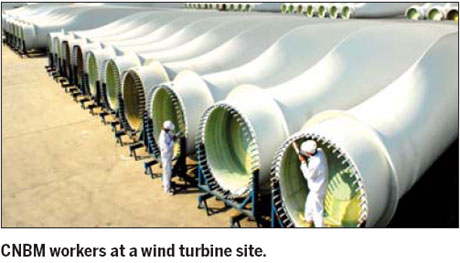Reports: Construction giant CNBM shows 'green' growth

BEIJING - China National Building Material Group Corp (CNBM), China's largest building materials manufacturer, released its first report on corporate social responsibility (CSR) on Monday in Beijing to showcase its commitment to sustainable growth.
A key player in an industry long known for its heavy pollution and high energy use, CNBM vowed to play a leading role to promote clean technology and upgrade the industry, the report said.
"We will make huge efforts to develop new green building materials and further reduce pollutants," Song Zhiping, chairman of CNBM, said at a press conference on its first CSR report.
"It is a good starting point for us to become more transparent and socially responsible - we will release the report every year," said Song.
At the press briefing Shao Ning, vice-chairman of the watchdog State Assets Supervision and Administration Commission, said "it is a requirement that SOEs publish their CSR reports every year".
Shao said CNBM is also one of the SOEs to undertake experimental board committee reform and introduce directors from outside to improve corporate governance.
CNBM now has 11 board members, six of them brought in from outside the company, the report said.
The company invited international authentication agency Bureau Veritas (BV) to assess its report.
"The report has responded to some key issues concerning the company's stakeholders," said Zheng Bin, a director with BV.
Sun Xiangyuan, vice-chairman of China's Building Materials Industry Association, noted that "CNBM has played a leading role of restructuring the industry and eliminating outdated capacity through acquisition of small building materials manufacturers around the country, specially around East China".
Sun said beginning this year the Ministry of Industry and Information Technology and the National Development and Reform Commission will close down small cement plants, which by 2013, will eliminate a combined 600 million tons from production.
"Through mergers and acquisitions at a number of smaller cement factories, we will eliminate low-tech production plants that cause high levels of pollution and require high levels of energy," said Song.
CNBM has also donated millions of yuan to a poverty alleviation program in Chizhou of Anhui province, where the company cooperated with the local municipal government on a 2 billion yuan new materials and clean energy industrial park, the report said.
In earthquake-hit Beichuan county of Sichuan province, China United Cement Corp, a unit of CNBM, opened a cement plant last December after only 10 months of construction to meet the demand for building materials in infrastructure reconstruction.
The new facility is equipped with a 9 megawatt low temperature waste heat power generation system designed to save 20,700 tons of standard coal usage and reduce CO2 emissions by 57,500 tons every year.
The company also signed agreements with several earthquake-hit cities in Sichuan province to support the post-quake reconstruction projects.
"The building materials industry has great potential for the recycling business and China currently has roughly 1.7 billion tons of coal waste available to be exploited," said Yao Yan, dean of China Building Materials Academy and president of CNBM.
CNBM's new cladding materials production lines can all utilize and reuse 20 million tons of industrial waste annually.
CNBM has eliminated more than 30 energy-inefficient vertical cement kilns with total capacities of 3 million tons.
The government and CNBM have pledged to improve energy efficiency by eliminating vertical kilns and promoting more advanced technologies using rotary kilns.
CNBM has also introduced advanced energy efficient dry-kiln cement production lines that can use waste heat to generate electricity.
Compared to the old vertical cement lines, a dry kiln cement plant can save 35 percent in electricity and reduce dust emissions by 30 percent.
China Daily
(China Daily 09/21/2010 page15)












